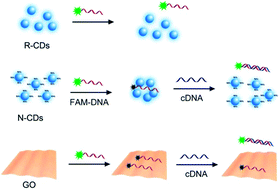Insight into the DNA adsorption on nitrogen-doped positive carbon dots†
Abstract
Considerable biosensors have been fabricated on the basis of DNA interaction with carbon nanomaterials, such as graphene oxide (GO) nanosheets. Few studies have focused on the rational design of sensors between carbon dots (CDs) and DNA due to the limited understanding of the real forces behind the adsorption of DNA on CDs. In this work, nitrogen doping-positive CDs (N-CDs), which can quench fluorophore-labeled DNA, were investigated to ascertain the interaction between the CDs and DNA. With reference to DNA adsorption on GO, the adsorption capacity and kinetics of N-CDs for DNA were studied. Desorption of DNA from these surfaces was also measured. Moreover, DNA desorption and anchoring force of N-CDs to DNA were different from those of GO, given that the prepared N-CDs and GO were positively and negatively charged, respectively. Accordingly, DNA was adsorbed on N-CDs mainly via electrostatic adsorption and other forces, such as nucleobase effect, hydrophobic interaction, and van der Waals (vdW) forces. This study enhanced the basic knowledge of DNA adsorption on some CDs for further study in the application of CDs in bioanalysis or biomedicine.



 Please wait while we load your content...
Please wait while we load your content...